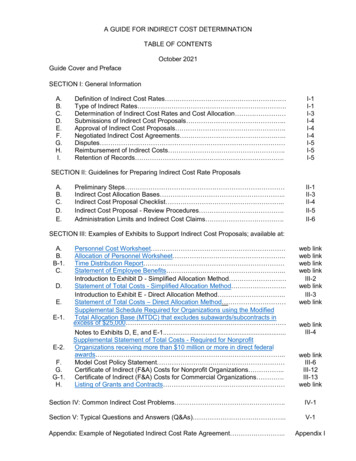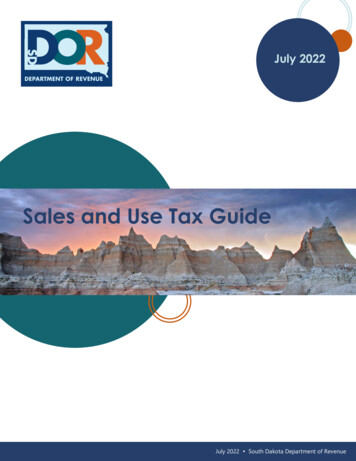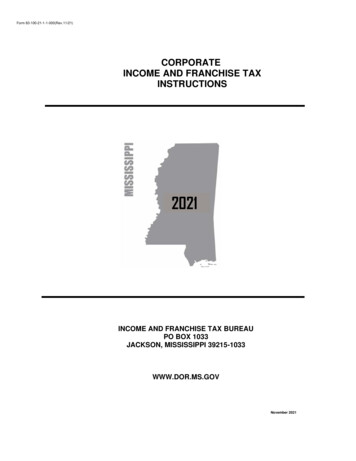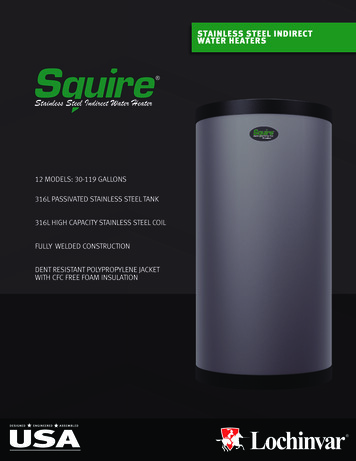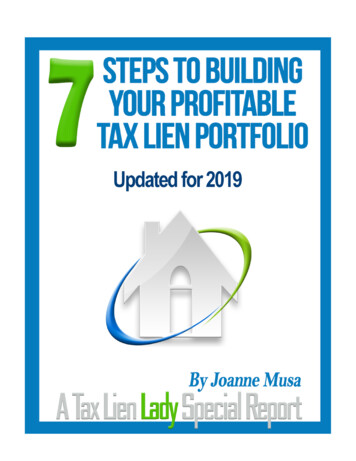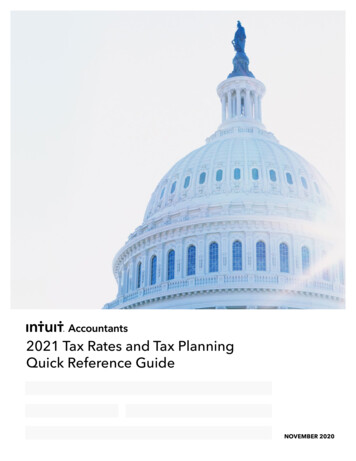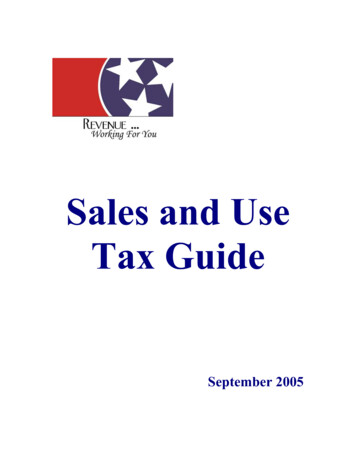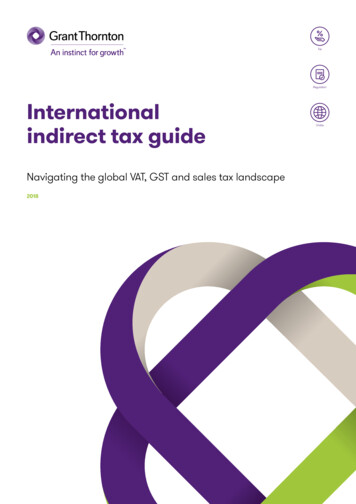
Transcription
TaxRegulationInternationalindirect tax guideNavigating the global VAT, GST and sales tax landscape2018Globe
ContentsAruba90Pakistan190Jersey 328The Bahamas 93Philippines193Republic of Kazakhstan 33105Belize96Singapore198Republic of Kosovo 334Trade blocs 08Bolivia99South Korea 202Kyrgyzstan338Global indirect tax rates10Brazil101Sri Lanka 206Liechtenstein341British Virgin Islands 12Luxembourg350Key highlights: Africa 13Caribbean Netherlands 110Vietnam215Republic of Macedonia 354Customs and trade:Africa14220Malta362Moldova367AlgeriaThe Netherlands eden419Switzerland424Turkey427Ukraine431United Kingdom 435Uzbekistan440Middle East 443Introduction – 100 years young01Customs duty Burkina Faso Côte d’Ivoire EgyptEthiopiaGabonGhanaGuineaRepublic of Kenya yman Islands 113EuropeChile114Key highlights: Europe 22115Colombia11722218Costa Rica 119Customs and �aoDominican Republic El Salvador MexicoNicaraguaPuerto Rico Saint Lucia Sint Maarten Trinidad and Tobago United States Uruguay121124127131134137141144147150153Asia Pacific 156Key highlights:Asia Pacific157158Bosnia and Herzegovina 243Bulgaria246Croatia250Cyprus255Czech Republic 84Germany288Senegal67Customs and trade:Asia Pacific70Australia159Gibraltar294Key highlights:Middle East444South Africa apan180Isle of Man 314Saudi Arabia 450Malaysia183Israel319United Arab Emirates 454186Italy322Contacts458Zimbabwe Americas8084Key highlights: Americas 85Customs and trade:North AmericaArgentina8687Hong Kong New Zealand This information has been provided by Grant Thornton member firms within Grant Thornton International Ltd and is for informational purposes only. Grant Thornton International Ltd cannotguarantee the accuracy, timeliness or completeness of the data contained herein. As such, you should not act on the information without first seeking professional tax advice from one of thecontacts at the rear of the publication.International indirect tax guide – Ready to respond 2
Introduction – 100 yearsyoungWelcome to the third edition of our International indirect tax guide2018 marks the 100th anniversary of the concept of ValueAdded Tax (VAT). VAT was the brainchild of a Germanindustrialist, Dr. Wilhelm von Siemens in 1918 – a hundredyears later, the tax which was devised to be efficient andrelatively simple to collect and enforce is together with Goodsand Services Tax (GST), now in place in over 140 countriesglobally.VAT/GST is still evolving, and an arguable simple tax is growingin its complexity and application as a traditional goodsand services model is replaced with digital content; virtualconsumption and seamless international trade flows.We are seeing many changes relating to registrationrequirements, digital reporting requirements, the approach toaudits and compliance by tax authorities and the approachesto taxing the digital economy. It has been said that we are nowliving in a volatile, uncertain, complex and ambiguous (VUCA)world, and in relation to international indirect taxes, this iscertainly the case.Unexpected election results (including the UK’s referendum onBrexit) have resulted in a range of changes in VAT/GST andcustoms regimes and there have also been unanticipateddecisions of the courts. Businesses are at the first line ofresponse with a need to respond to these changes and makesure they remain compliant, adhering to new requirementsacross the globe, often with short notice. There are numerouschallenges facing businesses, and below we have set outsome of the key international indirect tax trends that we andour clients are seeing and facing. Indirect tax has become agenuine commercial conversation now.Indirect tax is the new direct taxWhile there appears to be a trend for corporate income taxrates being lowered, VAT, GST and sales tax rates are generallyincreasing. Tax authorities are realising that taxing revenueand actual transactions can raise more revenue than simplyfocusing in on profit, which can often be subjective and subjectto manipulation. Put simply, it’s easier to tax the transactionsthat create the outcomes, rather than the outcomes themselves.When the transaction tax base is expanded to move out ofthe ‘physical’ and into the ‘virtual’, the reach of the indirecttax is extended significantly, and revenue collections growaccordingly. It is no wonder that numerous territories arelooking to introduce or re-shape existing VAT/GST systems.‘ It’s easier to tax the transactions thatcreate the outcomes, rather than theoutcomes themselves.’International indirect tax guide – 100 years young 1
‘ When a business prepares forimplementing VAT or GST, they shouldrecognise that VAT/GST is a businessissue not just a tax one and that thisis vital to the success of a VAT/GSTimplementation project.’New indirect tax systemsMany of the emerging markets are introducing new indirecttax systems. Over the last 12 months we have seen India carryout landmark economic reform by introducing GST, replacingseveral different taxes at a state or national level. We havealso seen the first two Gulf Cooperation Council (GCC) statesintroduce VAT – namely the United Arab Emirates and SaudiArabia. It’s also expected that the other GCC states will followshortly in 2019. In Malaysia, the country is repealing GST andreverting to a sales and services tax. China also continued itstax reform and has recently completed the final transition fromBusiness Tax on services to VAT.When a business prepares for implementing VAT or GST, theyshould recognise that VAT/GST is a business issue not justa tax one and that this is vital to the success of a VAT/GSTimplementation project. Appropriate time, resource and effortshould be focused on mapping the value chain, defining thevarious business use cases, and understanding the currentbusiness as usual position across people, process, technologyand data. Businesses should assess all information sourcesfor tax sensitive data and understand the impacts of VAT/GST,where there are gaps, what needs to change, and then developa project plan to get ready for the first day of implementation.Taxing the digital economyIt’s been 15 years since the European Union (EU) introducedspecific targeted legislation to tax the digital economy. It didthis by forcing non-EU businesses providing digital servicesto private consumers in the EU member states to register forVAT and charge VAT based on the customer location. Thislegislation was originally controversial, and businesses wereslow to comply. This is now a genuine trend and the legislationhas inspired similar laws across the globe. It seems that almostevery month another country announces new legislationtargeting non-resident supplies of digital services. This isparticularly a growing trend in the APAC region, includingAustralia who introduced the ‘Netflix’ tax, as well as, NewZealand, South Korea, and Taiwan. Singapore is also one ofseveral countries announcing similar future plans. There are lotsof challenges for businesses to consider, including identifyingand evidencing customer location, calculating and chargingthe right rate of tax, meeting local invoicing requirements, aswell as making payments in foreign currencies.Expanding definition of ‘nexus’ – WayfairIt is not just digital services that are increasingly being taxed inthe emerging digital economy, but also supplies of goods fromsuppliers outside of the country or state by online webstoresand online marketplaces. The recent ‘Wayfair’ decision in theUS could be the most significant indirect tax court decision in ageneration.On 21 June 2018, in a 5-4 decision, the US Supreme Courtdecided on South Dakota v. Wayfair, Inc., in a landmark caseconcerning sales and use tax nexus standards. The SouthDakota Supreme Court had held that a law requiring certainremote sellers to collect sales tax on sales made in the statewas unconstitutional because it violated the physical presencerequirement for sales and use taxes under Quill Corp. v. NorthDakota. A business traditionally needed to have a physicalpresence in a state to have a requirement to register andcharge sales tax in that state. The Supreme Court decisionnow opens the door for states to introduce new economicnexus standards, for example requiring businesses thatreceive revenue more than 100,000 from customers in a stateto register and charge sales tax. This is comparable to thedistance selling rules in the EU.This significant change in the sales and use tax nexus standardwarrants businesses to conduct a thorough review of theiractivities in US jurisdictions in which they do not have aphysical presence. Implications of existing economic nexusrules and those to be implemented in the future will need to beclearly understood and compliance obligations met. Just likeobtaining and validating VAT/GST numbers from customers,businesses with customers in the US should also consider howthey manage exemption certificates.Changes to customs processes – BrexitThe ‘Brexit’ decision of the British public to leave the EU haslarge possible ramifications across indirect taxes. It has alsoshone a light on supply chains, and customs duty, often seenas the ‘Cinderella’ tax, has gained more headlines in themedia. Businesses in the UK and Europe are now modelling thepotential impact of different trading relationship models oncash and cash-flow.International indirect tax guide – 100 years young 2
‘ The direction of travel for internationalindirect tax compliance is very clear, it’sdigital and near real-time.’In addition to Brexit, importers and exporters should also beaware that the UK is replacing its Customs Handling of Importand Export Freight (CHIEF) customs declaration system and willlaunch a new ‘Customs Declaration Service’ system in 2019 –another change for businesses to add to their roadmap to beprepared for. While there is uncertainty, many businesses arecarrying out ‘no regrets’ actions, for example looking to obtain‘trusted trader’ position by obtaining Authorised EconomicOperator (AEO) status.Digitalisation of VAT complianceThe direction of travel for international indirect tax complianceis very clear, it’s digital and near real-time.Historically, tax authorities accepted paper invoicing andadopted a ‘post-audit’ approach, where the taxpayer chargedtax on an invoice and this would only be audited after the fact.Often by a tax inspector or auditor physically looking at invoicesand records. This would often be based on sampling – a riskbased approach to compliance. Taxpayers themselves may haveonly needed to physically submit a periodic summary VAT/GSTreturn, often paper. However, the trends seen across the globeinclude a shift to mandatory electronic invoicing. An example ofthis is Italy which will introduce mandatory business-to-businesselectronic invoicing from January 2019.As well as the customer receiving an electronic invoice, manytax authorities also receive it as well as receiving tax, masterand transactional data in real time. This has already beenseen in Hungary, where the submission of invoice data tothe tax authority became mandatory in July 2018. Some taxauthorities can validate the invoice in real time, for examplein Argentina, an XML file is sent to the tax authority by thetaxpayer to request a corresponding electronic authorisationcode. Another trend is the mandatory submission of taxand transitional information through Standard Audit Filesfor Tax (SAF-T). The problem is that these are not standardor harmonised globally, and the format, contents and filingfrequency differs between countries – for example, some aresubmitted periodically while others are only upon request orduring an audit.Finally, taxpayers are facing new requirements to physicallysubmit a VAT/GST return electronically, for example the UK’s‘Making Tax Digital’ initiative will mandate businesses to submittheir VAT returns via an application programming interface (API)direct to the tax authority, either direct from approved softwareor via an API-enabled spreadsheet. Because of the digitalisationof VAT/GST compliance globally, businesses need to make surethey have confidence in the quality and integrity of their datathat the tax authorities now have access to. Businesses shouldnot only guarantee the completeness of customer and suppliermaster data that may drive a tax determination decision, butalso run proactive data analytics on historic transactions tohighlight any systematic errors.How long is it before VAT and GST are administered every time acredit card or digital payment solution is entered at source andthe VAT/GST is automatically populated to a return: buying acoffee at the local café will never be the same!Tax technologyTax technology continues to be another growing trend. Notonly has this been fuelled by the need to meet complex newtax compliance requirements, but also by the changing taxtechnology ecosystem.Avalara has recently listed on the New York stock exchange andsignificantly increased its global presence. Sovos has madeacquisitions including around electronic invoicing. Both Vertexand Thompson Reuters (ONESOURCE) have made several newsenior appointments and invested heavily in their internationalindirect tax product roadmap. All these tax technologycompanies are improving awareness of tax technology and thebenefits of indirect tax automation to businesses. Businessesare also starting to develop their own tax technology strategiesand roadmaps rather than simply looking to purchase astandalone solution to meet a single requirement. Businessesshould however realise that technology solutions are not ‘plugand play’. They need to clearly define the functional andtax requirements they need to meet and make sure that theconfiguration is properly designed in a scalable manner, thatthe solution is adequately tested and people trained.Tax authorities are increasingly making use of tax data bycarrying out sophisticated data analytics, reviewing the fulldata set looking for anomalies and errors to form the basisfor assessments of tax and penalties. Tax authorities are alsocomparing data submitted by different taxpayers, for examplematching a customer’s claim for input tax on a purchaseagainst a supplier’s declared output tax on the sale. We areseeing this in India and in Spain.International indirect tax guide – 100 years young 3
‘ Volatility is by its nature unpredictablebut if you are prepared your responsecan be pro-active.’Responding to a VUCA worldHow should businesses and their indirect tax functions respondto the changes and uncertainty in relation to internationalindirect taxes? We would suggest that businesses developspecialists that understand data and technology as well astax technical expertise. As well as utilising internal resources,businesses may want to engage third parties, local subjectmatter experts, to help understand the complexity of newrequirements. In any roadmaps and project plans, a buffershould be included to prepare for changes to requirements.Volatility is by its nature unpredictable but if you are preparedyour response can be pro-active or at least considered re-activerather than an instinctive or knee-jerk.Many of the international indirect tax issues and trendsdiscussed above touch different parts of the business, fromwarehousing and logistics, procurement, finance, legal,marketing and business line managers. Communicationwith stakeholders is key – know what challenges there arethroughout other parts of the business and the knock on effectof any decisions or outcomes.We hope you enjoy the International Indirect Tax Guide2018. Please do share any feedback with us and pleasedo join our VAT Club group on LinkedIn1 to view global VAT/GST and sales tax news, updates and thought leadershipon international indirect tax.Businesses should invest in information and data – collectingrelevant tax sensitive data from suppliers and customers, butalso in relation to tax rates and rules and new functional andtax requirements. This information needs to be interpreted andshared with stakeholders in the business. Building knowledgehelps inform decision making when there is uncertainty.For example, when you are going to start doing business inemerging markets, it’s important to understand the marketfrom an indirect tax perspective, including VAT/GST or sales taxregimes, planning around this is critical to success.Dan PowersTax service line leaderGrant Thornton International LtdAlex BaulfEditor, Grant Thornton’s VAT ClubGrant Thornton UK LLPRob ClarkeAmericas international indirect tax leaderGrant Thornton LLP (US)Experimenting and modelling (including data analytics) allowsan indirect tax function and the wider business to understandcause and effect, generate and test hypothesis. Ambiguityrequires clear, confident leadership which can be obtainedfrom knowing what your outcomes could be and understandingyour options.Lorraine ParkinAPAC international indirect tax leaderGrant Thornton SingaporeKaren RobbEMEA international indirect tax leaderGrant Thornton UK LLPTony WindleGlobal international indirect tax leaderGrant Thornton Australia1 national indirect tax guide – 100 years young 4
Customs dutyCustoms compliance, reliefs and statistical analysisMany companies have limited or no in-house customsexpertise. Where there is in-house customs expertise, it oftensits outside the main tax function, in the operations and logisticsdepartments of the business, where the commercial pressuresto keep supply chains moving may mean that key customs dutyprocesses are not always given maximum priority.The cost of getting customs duty compliance wrong can behigh. Consequences range from depriving your companyof valuable working capital, to reducing profit margins andproduct competitiveness. It’s, therefore, essential that the rightamount of customs duty is paid and that all available reliefsare claimed.Essentially there are three customs aspects that everycompany should address, as a matter of course:1 Customs compliance2 Reliefs3 Using import statistics and export statistics as a businessmanagement tool.Customs complianceThere tends to be the perception that customs is countryspecific. This notion neglects to account for the fact thereare three customs principles, or customs cornerstones, whichare international.Each of the cornerstones are subject to an internationalConvention or Agreement, tariff classification through a WorldCustoms Organization (WCO) Convention, and valuation andorigin through World Trade Organization (WTO) Agreements.Legislative nistrative FrameworkThe three cornerstones are: Tariff classification– What it is? Valuation– What is its price? Origin– Where it is from?International indirect tax guide – Customs duty 5
Tariff classificationAs an importer or exporter, you are responsiblefor the correct tariff classification of yourgoods. For this purpose, you would needto employ the Harmonized CommodityDescription and Coding System, generallyreferred to as a Harmonized System (HS). TheHS is widely held as the true ‘language ofinternational trade’.Internationally, the tariff includes around5,000 commodity groups, identified by asix-digit code, whilst the EU tariff includesadditional eight-digit subdivisions and legalnotes specifically created to address theneeds of the EU. aluationVIn essence, customs value transaction value price paid or payable adjustments –deductions.Customs valuation is the process to determinethe value of goods when entered under variouscustoms procedures, such as import, export,warehousing and processing.The primary method, the ‘transaction value’,applies first. Should it fail to determine acustoms value of the goods, then the fivesecondary methods need be considered.Essentially, it is the pursuit to determine theprice actually paid or payable for the goods. riginODetermining the origin of your goods is nolonger a simple endeavour. The country ofshipment does not necessarily constitute thecountry of origin of the goods. Where thegoods come from could well differ from thecountry from which they originate. Addingto the complication, raw materials andcomponents travel across country bordersen-route to manufacturing plants, beforebeing packaged and consigned to their finaldestination of use.Customs reliefsIt is possible, dependent on a company’s economic activity,to reduce their customs duty liability through the application,authorisation and use of a number of reliefs, which tends to becountry specific. The following provides an EU insight.Processing Inward Processing (IP)– Relief from customs duty and import VAT on theimportation of non-EU goods that are processed and thenexported outside the EU. Outward Processing (OP)– The temporary export of EU goods to be processed in anon-EU country. Upon re-entry to free circulation in theEU, the customs duty is only payable on the value addedin the non-EU country. The partial relief of the customsduty.Specific use Temporary Admission (TA)– Non-EU goods, which are intended for re-export after aspecific use, may be admitted with total or partial relieffrom customs duty without it being subject to othercharges. End Use (EnU)– A reduced or zero rate of customs duty applies on certaingoods imported into the EU that are put to a specific use,within a set time-period. The relief does not apply to VAT,excise duty or anti-dumping duty.Transit External– Goods that temporarily leave and re-enter the EU whilemaintaining the status of EU goods. The goods in transitdo not attract any customs duty, VAT and excise duty. Internal– Non-EU goods moved from one point to another within theEU. The goods in transit do not attract any customs duty,VAT and excise duty.International indirect tax guide – Customs duty 6
Storage Customs Warehousing (CW)– A storage facility that defers customs duty and/or importVAT, anti-dumping duty and Common Agricultural Policy(CAP) levy until the goods leave the CW or enter anothercustoms procedure. There are two types of CW – Publicand Private. Free Zones– A designated area where non-EU goods are treated asoutside the EU for customs duty purposes.Customs statistical analysisMore often than not companies neglect to appreciate the valueand the benefit derived in the analysis of their import statisticsand export statistics. This is surprising since for all their otherbusiness activities, statistics tends to be a critical part inmeasuring a company’s performance and compliance.A call to actionThe cost of getting customs duty compliance wrong can behigh. It’s essential that a company dedicate resources to thecustoms function. If such resource is not available within thecompany, it could be provided through a customs specialist.For further information on customs duty, please contact:Riaan de LangeT 44 (0)20 7728 2041E riaan.v.de.lange@uk.gt.comRichard MorleyT 44 (0)20 7184 4604E richard.d.morley@uk.gt.comImport and export statistics should not be seen as merelya transaction record, but rather a management tool, thatnot only questions customs compliance, but also providesopportunities for customs duty reduction and relief. InForm C88 – Single Administrative Data(SAD) Management Support System (MSS) Intrastat Form C79 – Import VAT Certificate Monthly Duty Deferment SchedulesInternational indirect tax guide – Customs duty 7
Trade blocsKnowing your trade blocs from your trade blocksTrade blocs is the term used when referring to the forms andstages of economic integration, which is increasingly shapingthe pattern of world trade. Trade blocs are inclusive of themovement of merchandise or goods, services, and people.Trade blocs are a depiction of the forms and stages of economicintegration. Far too often, the essence and characteristicsof trade blocs are misrepresented, misinterpreted or evenmisunderstood. Unfortunately trade blocs are not visuallyrepresented, which can cause them to not be fully understood.The table below attempts to help your understanding of trade blocs by providing you with a visual representation of the tradeblocs’ characteristics. The ‘x’ in the table below denotes what is applicable to the respective trade bloc (form and stage).EconomicIntegration Formsand StagesFree TradeZone*Free TradeAreaCustomsUnionCommonMarket orSingle MarketEconomicUnion**PoliticalUnionFree movementof goods–XXXXXCommonexternal tariff––XXXXFree movement offactor endowments–––XXXCommoneconomic policies––––XXCommon politicalenvironment–––––X* Free Trade Zone is not universally accepted as the first stage of economic integration, but it is included as it signals an intention for enhanced trade preferences.** The table does not include a Monetary Union, which refers to a trade bloc adopting a single currency for all member countries.International indirect tax guide – Trade blocs 8
Free Trade ZoneAlthough not universally accepted as the first stage ofeconomic integration, it is included as it signals an intention forenhanced trade preferences.Common market or single marketA common market or single market goes beyond a CustomsUnion by allowing the free movement of labour and capitalamong member countries.The World Bank defines a free trade zone as ‘customs duty freeareas, offering warehousing, storage, and distribution facilitiesfor trade, transshipment, and re-export operations.’Although the European Union (EU) is without question themost famous Single Market, examples of the Common Marketinclude the Common Market for Eastern and Southern Africa(COMESA), and Mercosur (Southern Cone Market) of SouthernAmerican states and the West African Common market.Free Trade Zones go by many names. Free Zones in the EU,whilst internationally Export Processing Zones (EPZs), FreeExport Zones, Export Free Zones, Industrial Free Zones, FreePorts or Industrial Development zones.The principle behind the establishment of the Zones aresimilar. It provides for the customs duty free importation of rawmaterial or components into the Zones where it is processedor manufactured into final products, which are then exported.The Zones are considered customs enclaves, as they operateoutside of the customs legislation of the country or territory inwhich they are based.These Zones are generally found adjacent to, or in quickproximity of, major seaports, international airports, andnational frontiers. These are areas which provide manygeographic advantages for trade.Free Trade Area (FTA)FTA can be easily confused with the acronym of the Free TradeAgreement. However, a Free Trade Area is the first stage ofeconomic integration where all barriers to trade, both tariff andnon-tariff barriers are removed amongst member countries.Although tariff (customs duty) barriers are removed betweenthe member countries, each country retains its own externalcustoms duty against imports from the rest of the world.Examples of FTAs include the Association of Southeast AsianNations (AEAS), European Free Trade Association (EFTA), theNorth American Free Trade Area (NAFTA) and the SouthernAfrican Development Community (SADC).Economic unionAn Economic Union extends on a common/single marketthrough harmonising or even unifying certain economic,monetary and fiscal policies and the regulatory environment ofmember countries.An example, which you could find confusing it that of the EU.This is offered in the context of a single currency, due to theadoption of one monetary policy.Political unionA political union is a type of state, which is composed of orcreated out of the unification of smaller states.A classic example is that of the now defunct Union of SovietSocialist Republics (USSR).Monetary unionA monetary union, also known as a currency union, is theinstance where two or more member countries share a commonor single currency. In the context of the EU, in certain memberstates, it is the Euro.The Economic and Monetary Union (EMU) is an umbrella termfor the group of policies aimed at converging the economiesof member states of the EU. The policies cover the 19 Eurozonestates, as well as non-euro EU states.Trade bloc considerationsIt’s possible for trade blocs to a have a trade creation and atrade diversion effect on member countries’ trade.Customs UnionA Customs Union is the second phase the regional integrationevolution, where a common external customs duty, also knownas a common external tariff (CEF) is introduced against importsfrom the rest of the world.Trade creation andtrade diversionTrade creation results when certain domestic production withina trade bloc is replaced by low-cost imports from anothermember country.The most famous example of a Customs Union is the EuropeanUnion (EU), although the oldest operational customs union inthe world is the Southern African Customs Union (SACU).Trade diversion results when lower-cost imports from outside atrade bloc is replaced by higher cost imports from a membercountry.For further information on customs duty, please contact:Riaan de LangeT 44 (0)20 7728 2041E riaan.v.de.lange@uk.gt.comInternational indirect tax guide – Trade blocs 9
Asia PacificAustraliaStandard rate: 10% Other: 0%CambodiaStandard rate: 10% Other: 0%ChinaStandard rate: 16% Other: 3-10%Hong KongDoes not currently levy any VAT, GST or sales taxIndiaStandard rate: 18% Other: 0%, 0.25%, 3%, 5%, 12%,18% and 28%IndonesiaStandard rate: 10% Other: 0%JapanStandard rate: 8%MalaysiaStandard rate: 0%Global indirect tax ratesAfricaAlgeriaStandard rate: 19% Other: 9%, 0%BotswanaStanda
International indirect tax guide - Ready to respond 2 This information has been provided by Grant Thornton member firms within Grant Thornton International Ltd and is for informational purposes only.

